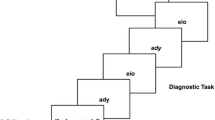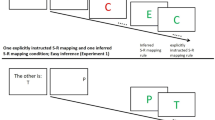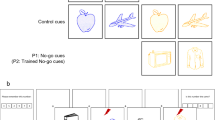Abstract
Previous behavioral and electrophysiological evidence has suggested that the instructions for a new choice task are processed even when they are not currently required, indicating intention-based reflexivity. Yet these demonstrations were found in experiments in which participants were set to execute a response (go). In the present experiment, we asked whether intention-based reflexivity would also be observed under unfavorable conditions in which participants were set not to respond (no-go). In each miniblock of our paradigm, participants received instructions for a task in which two new stimuli were mapped to right/left keys. Immediately after the instructions, a no-go phase began, which was immediately followed by a go phase. We found a significant stimulus-locked lateralized readiness potential in the first no-go trial, indicating reflexive operation of the new instructions. These results show that representing instructions in working memory provides sufficient conditions for stimuli to launch task processing, proceeding all the way until motor response-specific brain activation, which takes place even under unfavorable, no-go conditions.




Similar content being viewed by others
Notes
The Hebrew alphabet has only 22 letters, but some of the letters have a different shape when they come at the end of a word, a fact that enabled us to slightly increase the number of stimuli.
References
Anderson, J. R. (1982). Acquisition of cognitive skill. Psychological Review, 89, 369–406. doi:10.1037/0033-295X.89.4.369
Bargh, J. A. (1992). The ecology of automaticity: Toward establishing the conditions needed to produce automatic processing effects. American Journal of Psychology, 105, 181–199.
Besner, D., & Risko, E. F. (2005). Stimulus–response compatible orienting and the effect of an action not taken: Perception delayed is automaticity denied. Psychonomic Bulletin and Review, 12, 271–275. doi:10.3758/BF03196371
Braver, T. S. (2012). The variable nature of cognitive control: A dual mechanisms framework. Trends in Cognitive Sciences, 16, 106–113. doi:10.1016/j.tics.2011.12.010
Bugmann, G. (2012). Modeling fast stimulus–response association learning along the occipito-parieto-frontal pathway following rule instructions. Brain Research, 1434, 73–89. doi:10.1016/j.brainres.2011.09.028
Carrillo-de-la-Peña, M. T., Galdo-Álvarez, S., & Lastra-Barreira, C. (2008). Equivalent is not equal: Primary motor cortex (MI) activation during motor imagery and execution of sequential movements. Brain Research, 1226, 134–143.
Carrillo-de-la-Peña, M. T., Lastra-Barreira, C., & Galdo-Álvarez, S. (2006). Limb (hand vs. foot) and response conflict have similar effects on event-related potentials (ERPs) recorded during motor imagery and overt execution. European Journal of Neuroscience, 24, 635–643.
Chatham, C. H., Frank, M. J., & Badre, D. (2014). Corticostriatal output gating during selection from working memory. Neuron, 81, 930–942. doi:10.1016/j.neuron.2014.01.002
Cohen-Kdoshay, O., & Meiran, N. (2007). The representation of instructions in working memory leads to autonomous response activation: Evidence from the first trials in the flanker paradigm. Quarterly Journal of Experimental Psychology, 60, 1140–1154.
Cohen-Kdoshay, O., & Meiran, N. (2009). The representation of instructions operates like a prepared reflex: Flanker compatibility effects found in first trial following S–R instructions. Experimental Psychology, 56, 128–133. doi:10.1027/1618-3169.56.2.128
Cole, M. W., Bagic, A., Kass, R., & Schneider, W. (2010). Prefrontal dynamics underlying rapid instructed task learning reverse with practice. Journal of Neuroscience, 30, 14245–14254. doi:10.1523/JNEUROSCI.1662-10.2010
Cole, M. W., Laurent, P., & Stocco, A. (2013). Rapid instructed task learning: A new window into the human brain’s unique capacity for flexible cognitive control. Cognitive, Affective, & Behavioral Neuroscience, 13, 1–22. doi:10.3758/s13415-012-0125-7
Cole, M. W., & Schneider, W. (2007). The cognitive control network: Integrated cortical regions with dissociable functions. NeuroImage, 37, 343–360. doi:10.1016/j.neuroimage.2007.03.071
Coles, M. G. H. (1989). Modern mind-brain reading: Psychophysiology, physiology, and cognition. Psychophysiology, 26, 251–269.
De Houwer, J., Beckers, T., Vandorpe, S., & Custers, R. (2005). Further evidence for the role of mode-independent short-term associations in spatial Simon effects. Perception & Psychophysics, 67, 659–666. doi:10.3758/BF03193522
Delorme, A., & Makeig, S. (2004). EEGLAB: An open source toolbox for analysis of single-trial EEG dynamics including independent component analysis. Journal of Neuroscience Methods, 134, 9–21. doi:10.1016/j.jneumeth.2003.10.009
Dumontheil, I., Thompson, R., & Duncan, J. (2011). Assembly and use of new task rules in fronto-parietal cortex. Journal of Cognitive Neuroscience, 23, 168–182. doi:10.1162/jocn.2010.21439
Duncan, J. (2010). The multiple-demand (MD) system of the primate brain: Mental programs for intelligent behaviour. Trends in Cognitive Sciences, 14, 172–179. doi:10.1016/j.tics.2010.01.004
Eimer, M., & Schlaghecken, F. (1998). Effects of masked stimuli on motor activation: Behavioral and electrophysiological evidence. Journal of Experimental Psychology: Human Perception and Performance, 24, 1737–1747.
Eimer, M., & Schlaghecken, F. (2003). Response facilitation and inhibition in subliminal priming. Biological Psychology, 64, 7–26. doi:10.1016/S0301-0511(03)00100-5
Everaert, T., Theeuwes, M., Liefooghe, B., & De Houwer, J. (in press). Automatic motor activation by mere instruction. Cognitive, Affective, & Behavioral Neuroscience. doi:10.3758/s13415-014-0294-7
Frank, M. J., & O’Reilly, R. C. (2006). A mechanistic account of striatal dopamine function in human cognition: Psychopharmacological studies with cabergoline and haloperidol. Behavioral Neuroscience, 120, 497–517.
Galdo-Álvarez, S., & Carrillo de la Peña, M. T. (2004). ERP evidence of MI activation without motor response execution. NeuroReport, 15, 2067–2070.
Ganor-Stern, D., Tzelgov, J., & Meiran, N. (2013). How are automatic processes elicited by intended actions? Frontiers in Psychology, 4, 851. doi:10.3389/fpsyg.2013.00851
Gratton, G., Coles, M. G. H., Sirevaag, E. J., Eriksen, C. W., & Donchin, E. (1988). Pre- and poststimulus activation of response channels: A psychophysiological analysis. Journal of Experimental Psychology: Human Perception and Performance, 14, 331–344. doi:10.1037/0096-1523.14.3.331
Guthrie, D., & Buchwald, J. S. (1991). Significance testing of difference potentials. Psychophysiology, 28, 240–244.
Hohlefeld, F. U., Nikulin, V. V., & Curio, G. (2011). Visual stimuli evoke rapid activation (120 ms) of sensorimotor cortex for overt but not for covert movements. Brain Research, 1368, 185–195. doi:10.1016/j.brainres.2010.10.035
Hollands, J. G., & Jarmasz, J. (2010). Revisiting confidence intervals for repeated measures designs. Psychonomic Bulletin & Review, 17, 135–138. doi:10.3758/PBR.17.1.135
Hommel, B. (2000). The prepared reflex: Automaticity and control in stimulus response translation. In S. Monsell & J. Driver (Eds.), Control of cognitive processes: Attention and performance XVIII (pp. 247–273). Cambridge, MA: MIT Press.
Huang, T. R., Hazy, T. E., Herd, S. A., & O’Reilly, R. C. (2013). Assembling old tricks for new tasks: A neural model of instructional learning and control. Journal of Cognitive Neuroscience, 25, 843–851.
Jarmasz, J., & Hollands, J. G. (2009). Confidence intervals in repeated-measures designs: The number of observations principle. Canadian Journal of Experimental Psychology, 63, 124–138.
Kopp, B., Mattler, U., Goertz, R., & Rist, F. (1996). N2, P3 and the lateralized readiness potential in a nogo task involving selective response priming. Electroencephalography and Clinical Neurophysiology, 99, 19–27.
Kornblum, S., Hasbroucq, T., & Osman, A. (1990). Dimensional overlap: Cognitive basis for stimulus–response compatibility-a model and taxonomy. Psychological Review, 97, 253–270. doi:10.1037/0033-295X.97.2.253
Kranczioch, C., Mathews, S., Dean, P. J. A., & Sterr, A. (2009). On the equivalence of executed and imagined movements: Evidence from lateralized motor and nonmotor potentials. Human Brain Mapping, 30, 3275–3286.
Liefooghe, B., De Houwer, J., & Wenke, D. (2013). Instruction-based response activation depends on task preparation. Psychonomic Bulletin & Review, 20, 481–487.
Liefooghe, B., Wenke, D., & De Houwer, J. (2012). Instruction-based task-rule congruency effects. Journal of Experimental Psychology: Learning, Memory, and Cognition, 38, 1325–1335.
Logan, G. D. (1988). Toward an instance theory of automatization. Psychological Review, 95, 492–527. doi:10.1037/0033-295X.95.4.492
Logan, G. D. (1992). Attention and preattention in theories of automaticity. American Journal of Psychology, 105, 317–339.
Luck, S. J. (2005). An introduction to the event-related potential technique. Cambridge, MA: MIT Press.
Meiran, N., & Cohen-Kdoshay, O. (2012). Working memory load but not multitasking eliminates the prepared reflex: Further evidence from the adapted flanker paradigm. Acta Psychologica, 139, 309–313. doi:10.1016/j.actpsy.2011.12.008
Meiran, N., Cole, M. W., & Braver, T. S. (2012). When planning results in loss of control: Intention-based reflexivity and working-memory. Frontiers in Human Neuroscience, 6, 104. doi:10.3389/fnhum.2012.00104
Meiran, N., Pereg, M., Kessler, Y., Cole, M. W., & Braver, T. S. (in press). The power of instructions: Proactive configuration of stimulus–response translation. Journal of Experimental Psychology: Learning, Memory, and Cognition. doi:10.1037/a0037190
Miller, E. K., & Cohen, J. D. (2001). An integrative theory of prefrontal cortex function. Annual Review of Neuroscience, 24, 167–202. doi:10.1146/annurev.neuro.24.1.167
Moors, A., & De Houwer, J. (2006). Automaticity: A conceptual and theoretical analysis. Psychological Bulletin, 132, 297–326. doi:10.1037/0033-2909.132.2.297
Munzert, J., Lorey, B., & Zentgraf, K. (2009). Cognitive motor processes: The role of motor imagery in the study of motor representations. Brain Research Reviews, 60, 306–326.
Ramamoorthy, A., & Verguts, T. (2012). Word and deed: A computational model of instruction following. Brain Research, 1439, 54–65. doi:10.1016/j.brainres.2011.12.025
Rosenbloom, P. S., & Newell, A. (1986). The chunking of goal hierarchies: A generalized model of practice. In R. S. Michaliski, J. G. Carbonell, & T. M. Mitchell (Eds.), Machine learning: An artificial intelligence approach (Vol. 2, pp. 247–288). Los Altos, CA: Morgan Kaufmann.
Ruge, H., & Wolfensteller, U. (2010). Rapid formation of pragmatic rule representations in the human brain during instruction-based learning. Cerebral Cortex, 20, 1656–1667. doi:10.1093/cercor/bhp228
Schneider, W., Eschman, A., & Zuccolotto, A. (2012). E-Prime User's Guide. Pittsburgh: Psychology Software Tools, Inc.
Shahar, N., Teodorescu, A. R., Usher, M., Pereg, M., & Meiran, N. (in press). Selective influence of working memory load on exceptionally slow reaction times. Journal of Experimental Psychology: General. doi:10.1037/a0037190
Shiffrin, R. M., & Schneider, W. (1977). Controlled and automatic human information processing: II. Perceptual learning, automatic attending and a general theory. Psychological Review, 84, 127–190. doi:10.1037/0033-295X.84.2.127
Smulders, F. T. Y., & Miller, J. O. (2012). The lateralized readiness potential. In S. J. Luck & E. S. Kappenman (Eds.), Oxford handbook of event-related potential components (pp. 209–230). New York, NY: Oxford University Press. doi:10.1093/oxfordhb/9780195374148.013.0115
Stocco, A., Lebiere, C., O’Reilly, R. C., & Anderson, J. R. (2012). Distinct contributions of the caudate nucleus, rostral prefrontal cortex, and parietal cortex to the execution of instructed tasks. Cognitive, Affective, & Behavioral Neuroscience, 12, 611–628. doi:10.3758/s13415-012-0117-7
Tzelgov, J. (1997). Automatic but conscious: That is how we act most of the time. In R. Wyer (Ed.), Advances in social cognition (Vol. 10, pp. 217–230). Mahwah, NJ: Erlbaum.
Verbruggen, F., & Logan, G. D. (2009). Automaticity of cognitive control: Goal priming in response-inhibition paradigms. Journal of Experimental Psychology: Learning, Memory, and Cognition, 35, 1381–1388. doi:10.1037/a0016645
Verbruggen, F., Logan, G. D., Liefooghe, B., & Vandierendonck, A. (2008). Short-term aftereffects of response inhibition: Repetition priming or between-trial control adjustments? Journal of Experimental Psychology: Human Perception and Performance, 34, 413–426. doi:10.1037/0096-1523.34.2.413
Wenke, D., Gaschler, R., & Nattkemper, D. (2007). Instruction-induced feature binding. Psychological Research, 71, 92–106. doi:10.1007/s00426-005-0038-y
Wenke, D., Gaschler, R., Nattkemper, D., & Frensch, P. A. (2009). Strategic influences on implementing instructions for future actions. Psychological Research, 73, 587–601. doi:10.1007/s00426-009-0239-x
Author Note
This research was supported by a research grant from the USA–Israel Bi-national Science Foundation to the first and last authors. We thank Florian Waszak for a stimulating discussion that was instrumental in generating this line of research.
Author information
Authors and Affiliations
Corresponding author
Rights and permissions
About this article
Cite this article
Meiran, N., Pereg, M., Kessler, Y. et al. Reflexive activation of newly instructed stimulus–response rules: evidence from lateralized readiness potentials in no-go trials. Cogn Affect Behav Neurosci 15, 365–373 (2015). https://doi.org/10.3758/s13415-014-0321-8
Published:
Issue Date:
DOI: https://doi.org/10.3758/s13415-014-0321-8




